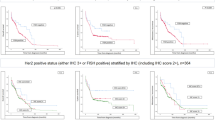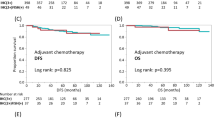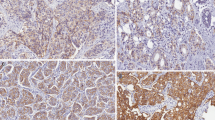Abstract
Background
Phosphorylated HER2 (pHER2) may more accurately reflect the signaling and functional activity of the HER2 protein than detection of HER2 itself. The detection of HER2 gene amplification using fluorescence in situ hybridization (FISH) provides superior prognostic information for the diagnosis of breast cancer. However, the relationship between pHER2 expression in tissue samples and HER2 gene amplification remains unclear.
Methods
A total of 210 cases were recruited. The expression of HER2 and tyrosine (Tyr)1248-pHER2 was investigated by immunohistochemistry, and HER2 gene amplification was analyzed by FISH. Spearman’s rank correlation test was employed to confirm correlation between HER2 and Tyr1248-pHER2. Chi-square and Student’s t test were used to determine a significant difference between the baseline characteristics of tumors and the FISH, HER2 and Tyr1248-pHER2 results. The phosphorylation rate of HER2 was calculated using a digital-analysis system.
Results
HER2 expression was significantly (P < 0.001) associated with Tyr1248-pHER2 expression. HER2 gene amplification could be detected in 55 (26.2%) of the 210 tumors; 40 were HER2 positive and 32 were Tyr1248-pHER2 positive. The sensitivity and specificity of HER2 and Tyr1248-pHER2 for HER2 gene amplification were 72.7 and 58.2%, and 91.6 and 95.5%, respectively. In cases with an HER2 score of 2, and a phosphorylation score of 2 or 3, gene amplification was observed in 4 (80.0%) out of 5 tumors.
Conclusions
Tyr1248-pHER2 expression is highly specific for HER2 gene amplification. The phosphorylation status might provide an adjunct to the assessment of gene amplification in patients with an HER2 score of 2.



Similar content being viewed by others
Abbreviations
- p:
-
Phosphorylated
- FISH:
-
Fluorescence in situ hybridization
- IHC:
-
Immunohistochemistry
References
Muthuswamy SK, Gilman M, Brugge JS. Controlled dimerization of ErbB receptors provides evidence for differential signaling by homo and heterodimers. Mol Cell Biol. 1999;19:6845–57.
Lohrisch C, Piccart M. An overview of HER2. Semin Oncol. 2001;28(Suppl 18):3–11.
Dolan M, Snover D. Comparison of immunohistochemical and fluorescence in situ hybridization assessment of HER-2 status in routine practice. Am J Clin Pathol. 2005;123:766–70.
Wolff AC, Hammond ME, Schwartz JN, Hagerty KL, Allred DC, Cote RJ, Dowsett M, Fitzgibbons PL, Hanna WM, Langer A, McShane LM, Paik S, Pegram MD, Perez EA, Press MF, Rhodes A, Sturgeon C, Taube SE, Tubbs R, Vance GH, van de Vijver M, Wheeler TM, Hayes DF. American Society of Clinical Oncology/College of American Pathologists Guideline Recommendations for Human Epidermal Growth Factor Receptor 2 Testing in Breast Cancer. Arch Pathol Lab Med. 2007;131:18.
Thor AD, Liu S, Edgerton S, Moore D 2nd, Kasowitz KM, Benz CC, Stern DF, DiGiovanna MP. Activation (tyrosine phosphorylation) of ErbB-2 (HER-2/neu): a study of incidence and correlation with outcome in breast cancer. J Clin Oncol. 2000;18:3230–9.
The Japanese Breast cancer Society. General Rules for Clinical and Pathological Recording of Breast Cancer (in Japanese), 15th edn. Tokyo: Kanehara.
Tavassoli FA, Devilee P. WHO classification of tumours, pathology and genetics, tumours of the breast and female genital organs. Lyon: IARC press; 2002.
American Joint Committee on Cancer. AJCC cancer staging manual. 6th edn. New York: Springer; 2002.
Jacobs TW, Gown AM, Yaziji H, Barnes MJ, Schnitt SJ. Specificity of HercepTest in determining HER-2/neu status of breast cancers using the United States Food and Drug Administration-approved scoring system. J Clin Oncol. 1999;17:1983–7.
Vinatzer U, Dampier B, Streubel B, Pacher M, Seewald MJ, Stratowa C, Kaserer K, Schreiber M. Expression of HER2 and the coamplified genes GRB7 and MLN64 in human breast cancer: quantitative real-time reverse transcription-PCR as a diagnostic alternative to immunohistochemistry and fluorescence in situ hybridization. Clin Cancer Res. 2005;11:8348–57.
Moore JG, To V, Patel SJ, Sneige N. HER-2/neu gene amplification in breast imprint cytology analyzed by fluorescence in situ hybridization: direct comparison with companion tissue sections. Diagn Cytopathol. 2000;23:299–302.
Pauletti G, Dandekar S, Rong H, Ramos L, Peng H, Seshadri R, Slamon DJ. Assessment of methods for tissue-based detection of the HER-2/neu alteration in human breast cancer: a direct comparison of fluorescence in situ hybridization and immunohistochemistry. J Clin Oncol. 2000;18:3651–64.
Hatanaka Y, Hashizume K, Kamihara Y, Itoh H, Tsuda H, Osamura RY, Tani Y. Quantitative immunohistochemical evaluation of HER2/neu expression with HercepTestTM in breast carcinoma by image analysis. Pathol Int. 2001;51:33–6.
Lottner C, Schwarz S, Diermeier S, Hartmann A, Knuechel R, Hofstaedter F, Brockhoff G. Simultaneous detection of HER2/neu gene amplification and protein overexpression in paraffin-embedded breast cancer. J Pathol. 2005;205:577–84.
Hashizume K, Hatanaka Y, Kamihara Y, Tani Y. Automated immunohistochemical staining of formalin-fixed and paraffin-embedded tissues using a catalyzed signal amplification method. Appl Immunohistochem Mol Morphol. 2001;9:54–60.
Taniyama K, Goodison S, Ito R, Bookstein R, Miyoshi N, Tahara E, Tarin D, Urquidi V. PTEN expression is maintained in sporadic colorectal tumours. J Pathol. 2001;194:341–8.
Hudelist G, Kostler WJ, Attems J, Czerwenka K, Muller R, Manavi M, Steger GG, Kubista E, Zielinski CC, Singer CF. Her-2/neu-triggered intracellular tyrosine kinase activation: in vivo relevance of ligand-independent activation mechanisms and impact upon the efficacy of trastuzumab-based treatment. Br J Cancer. 2003;89:983–91.
Chen JS, Lan K, Hung MC. Strategies to target HER2/neu overexpression for cancer therapy. Drug Resist Updat. 2003;6:129–36.
Chan CT, Metz MZ, Kane SE. Differential sensitivities of trastuzumab (Herceptin)-resistant human breast cancer cells to phosphoinositide-3 kinase (PI-3K) and epidermal growth factor receptor (EGFR) kinase inhibitors. Breast Cancer Res Treat. 2005;91:187–201.
Modi S, DiGiovanna MP, Lu Z, Moskowitz C, Panageas KS, Van Poznak C, Hudis CA, Norton L, Tan L, Stern DF, Carter D, Seidman AD. Phosphorylated/activated HER2 as a marker of clinical resistance to single agent taxane chemotherapy for metastatic breast cancer. Cancer Invest. 2005;23:483–7.
Li X, Lu Y, Liang K, Liu B, Fan Z. Differential responses to doxorubicin-induced phosphorylation and activation of Akt in human breast cancer cells. Breast Cancer Res. 2005;7:R589–97.
Author information
Authors and Affiliations
Corresponding author
About this article
Cite this article
Taniyama, K., Ishida, K., Toda, T. et al. Tyrosine1248-phosphorylated HER2 expression and HER2 gene amplification in female invasive ductal carcinomas. Breast Cancer 15, 231–240 (2008). https://doi.org/10.1007/s12282-007-0026-8
Received:
Accepted:
Published:
Issue Date:
DOI: https://doi.org/10.1007/s12282-007-0026-8




